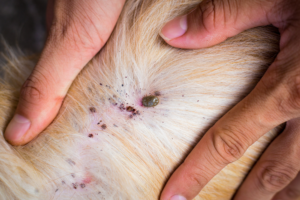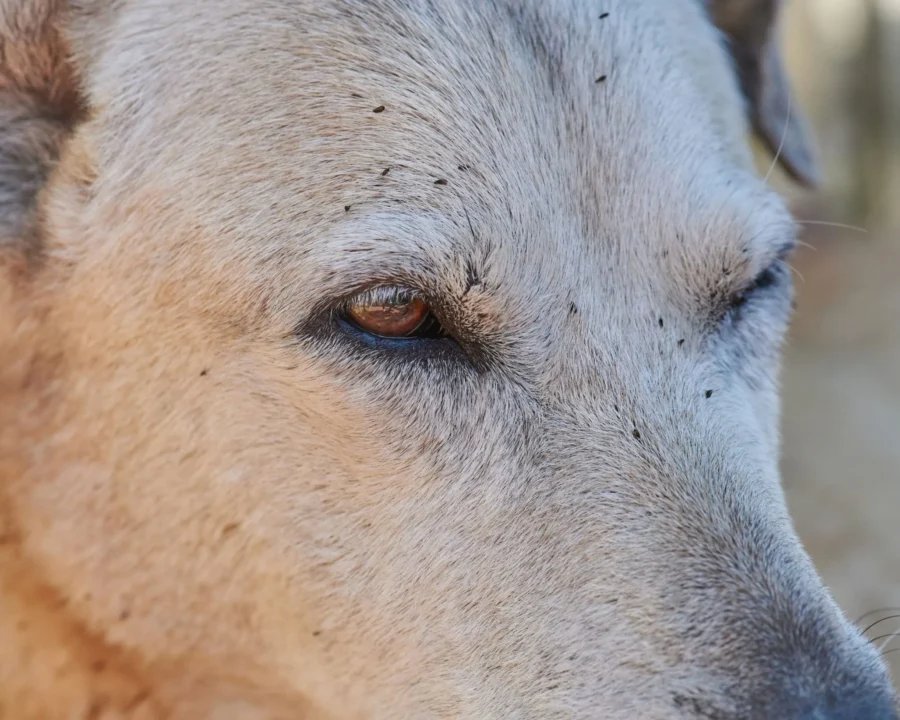Astonishing Facts Reveal What Fleas On Dogs Do To Jeopardize The Health of Pets and Children
The major health concerns of what fleas on dogs do are allergy dermatitis, tapeworms. anemia and bordetellosis. This article will provide a good understanding of the ways fleas present significant danger to dogs and children, signs of fleas on pets and what owners should do in case of an infestation.
How Are Fleas Dangerous to Dogs?

Fleas are parasites that attach themselves to a dog’s skin and draw its blood. The most common species is the cat flea, Ctenocephalides felis, which is a misnomer because they actually are as dangerous to dogs as cats. Following are explanations of the four primary problems of what fleas on dogs do to pose health risks.
Danger #1 – Flea Allergy Dermatitis
When a flea bites a dog, it injects a small amount of saliva into its skin. Many dogs develop an allergy to the released saliva causing a reaction. Severe itching and scratching may last up to two weeks after the fleas are eliminated causing the dog to experience skin issues. Dogs typically show hair loss, redness, skin thickening and “hotspots” over their hindquarters, tail head, bellies and thighs.
An article published in the US National Library of Medicine National Institutes of Health describes in detail what to expect after a dog is bitten by fleas. The biting of adult fleas is followed by a delayed reaction and skin irritation. The lesions initially appear as single or clustered small hemorrhage areas and within minutes wheel forms around the bites. At this point, the dog will begin to itch. The bites may become a hard papillary lesions. Repeated exposure to flea bites often induces a condition called flea allergy dermatitis. This infliction presents itself as erythema, alopecia, excoriation, papules, crusts, and itching, which unfortunately often leads to self traumas. Flea allergy dermatitis is one of the most frequent reasons pet owners seek veterinary advice.

According to the School of Veterinary Medicine, “The only long-term efficacious and safe therapy for flea allergy dermatitis is to keep the pet from being bitten by fleas. This may seem like an impossible task, but it is not. Remember, successful resolution of the flea-allergic animal’s misery requires that the fewest number of fleas bite the pet.”
Danger #2 – Bordetellosis, Commonly Referred to as Kennel Cough
While the jury is still out as to all of the sources of the bordetellosis, it has been linked to fleas on pets. Bordetellosis is caused by bacterium known as bartonella. Symptoms of bordetellosis infections in dogs primarily manifest as a persistent cough that sounds like that of a honking goose. Veterinarians refer to this as reverse sneezing. Loss of appetite, nausea, diarrhea, fever, excessive eye discharge and a continual runny nose are other symptoms caused by bordetellosis infection in dogs. Most dogs receive a vaccine to prevent this disease from being contracted, but it is not always reliable.
The article “Recent Advances in Canine Infectious Diseases” published by International Veterinary Information Service and written by D.J. Keil and B. Fenwick says, “ Our studies, as well as the experience of veterinarians and dog owners, leave little doubt that current vaccines do not adequately protect dogs against bordetellosis.”
Danger #3 -Tapeworms Can Result from Ineffective Flea Prevention
The initial cause of most tapeworm infestations is a result of ingesting adult fleas that carry the worm. Dogs often swallow these adult fleas while licking or grooming themselves or chewing at irritated skin from bites. They may even ingest fleas if they are trying to groom another pet or animal that has them.
Once ingested, a dog can easily become infected with tapeworms as they attach themselves to a dog’s intestinal lining by using their hook-like mouthparts. A tapeworm’s body includes a head, neck and chain of segments called proglottids. Once a tapeworm is secured to the dog’s intestinal wall the proglottids continues to grow and produce eggs. Without treatment, tapeworms can outlive the dog. Symptoms include itchiness or irritation around the anus, licking the area or scooting. If the dog has tapeworms, pieces of the worms will appear around its backside. These pieces, which look like grains of white rice, are packets of tapeworm eggs. A closer look may show them moving. Once the outer casing of these packets dries out, the eggs are released into the environment and the cycle is likely to be repeated.
Another sign of a dog having tapeworms is the appearance of light-colored segments of the worms near the anus or in the dog’s feces. These proglottids are shed in the intestines and passed in feces. The proglottids also may appear in vomit. It’s rare for dogs to show signs of illness when they have tapeworms, but they may have weight loss if the infestation is severe.
Danger #4 – Anemia Caused by Flea Infestations
Fleas reproduce rapidly. One flea on a dog can turn into hundreds quickly, feeding off of the dog’s blood. This can easily result in the dog becoming anemic, which means his blood count is low. Anemia is serious, particularly in puppies, and must be addressed immediately. Symptoms include lethargy, weakness, rapid breathing and potentially death if the fleas are not killed and the blood count stabilized.
Mar Vista Animal Medical Center says “Every summer at least one of our patients dies from excessive fleas. It is hard to imagine that something as tiny as a flea could be dangerous. We all know that fleas can make pets itch. Some of us are all too familiar with the spectacular skin inflammation in a flea-bite allergic pet but many people forget that fleas drink blood and that lots of fleas can drink lots of blood. The physical state of inadequate red blood cells is called: Anemia, and when it is severe enough, it is a life-threatening condition.”
What Fleas on Dogs Do to Present Danger to Children

An article published by Purdue University Extension says cat fleas also pose a threat to children.
“Cat fleas also are one of the hosts of the double pore dog tapeworm, Dipylidium caninum. This tapeworm is a parasite of dogs and cats, but it can infect children who ingest a flea in which an immature stage of the tapeworm exists. The immature stage of the tapeworm emerges from the ingested flea and begins to develop in the intestine of the child. This tapeworm does not cause obvious symptoms and is not a cause of serious disease, but dog owners should consult with a physician if an infection is suspected. The most obvious sign of infection in a child is the appearance of a stage of the tapeworm, known as a “proglottid,” in a child’s bowel movement. A proglottid is whitish, about the size and shape of a pumpkin seed, and capable of undulating movements.”
Any suspicion of tapeworms is reason to visit a veterinarian for treatment. There are several forms of tapeworm medications for dogs, including drugs like praziquantel, which can dissolve tapeworms in the intestines. Some tapeworm medications are available over the counter, but even these should be used only with veterinary recommendation.
What Fleas on Dogs Look Like

Fleas may be only 1 to 2mm long and sometimes are hard to differentiate between a piece of dirt or flea feces, commonly known as flea dirt. If a dog has fleas, they may red, irritated and dry broken skin patches on the neck, ears, abdomen and hindquarters become apparent. What fleas on dogs do is migrate to the thicker areas of a dog’s coat to hide, such as near joints, the base of the tail, and between folds in the neck.
There are several ways to check for fleas on pets. Combing against the fur shafts allows for a good look at the skin. Fleas may appear red or brown in color. Fleas don’t turn from their reddish-brown color when they die. To distinguish dead fleas from flea feces, the live fleas will be larger, approximately 1/16” to 1/8” long, which is about the size of a small grain of rice

If a pet is scratching and biting himself frequently, this is often the first sign the dog has fleas. Part the dog’s hair and see if there are fleas jumping. Even a single flea can turn into hundreds quickly.
Another recommended flea check is to use a fine comb on the pet in an empty bathtub. Make sure to wear gloves and log sleeves, as fleas jump and they like human blood as much as that of dogs. If black specks drop from the dog, drop some water on them. If the specks turn red, it is an indication of blood excrement from an adult flea. A visit to the veterinarian is suggested.
What Fleas on Dogs Do To Turn a Home Into a Breeding Ground
Dogs are the main transporters of fleas, so chances are it’s a pooch that will bring the infestation into a home. Getting rid of fleas on pets is hard. But getting rid of fleas in the house is a nightmare, as they are good at hiding and may be undetectable even in the most obvious places.
A favorite flea hideout in the home is in carpets and rugs. They provide a perfect environment for the eggs and larva to feed on the debris within the carpet, giving them what they need to quickly become adults. It is because fleas have the ability to jump, the vicious cycle continues, and the dog once again gets infected.
Beds are another flea breeding ground. If there is any indication the dog has a flea infestation, check under the pet’s bedding as well as human beds in the home. Fleas do not discriminate on where the blood comes from. Fleas find dogs’ and humans’ blood equally appealing.
Calcium carbonate and diatomaceous earth is a natural way to rid a home of fleas. These compounds may be used on carpeting, pet bedding and furniture. Because they are fine powders, they get into cracks and crevices on hardwood, tile, and linoleum floors easily and destroy fleas and other insects.
Areas and Climates Where Fleas Exist May Require Extra Flea Protection
Fleas prefer warm, moist environments and are most active from July through October. However, fleas have been known to live all the way into late November and then reappear as early as February. Fleas on pets are most abundant during warm and humid winters and spring. Pet owners in these areas may call for extra attention to flea prevention treatment.

While adult fleas survive by feeding on the blood of their host, they can live for several months without food. Flea larvae mostly thrive on organic debris, but they too need blood and get it from excrement deposited by adult fleas.
The flea life cycle has four stages: egg, larva, pupa and adult. It takes approximately 15 days to develop into an adult flea in typical circumstances. A female flea typically lays 4 to 8 eggs on a dog after every blood meal and up to 50 eggs per day. In a lifetime, a flea will normally lay 400 to 500 eggs. These eggs do not attach to the dog’s hair, but instead fall off, landing in places the dog visits most. It takes between two days and two weeks before the eggs hatch. It can take a flea anywhere from two weeks to eight months to become an adult depending on the temperature, humidity and food resources. Fleas often hibernate during the winter in their larval or pupal stages. They envelop themselves into a silky cocoon and remain there during the pupal stage. Adults will not emerge until they detect body heat, noise, vibrations and breathing. They have found their host! They are ready to start a new flea infestation. And with so many issues pet owners may face from what fleas on dogs do, it’s important to research and find the right course of flea prevention to keep dogs and children safe.
We hope you learned from this article. You can learn more about us at our About Us page.





